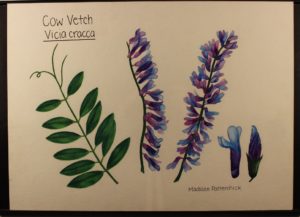 Cow Vetch, Madison Pasterchick |
| Common Name(s) |
Cow vetch, Tufted vetch, Cat peas |
| Scientific Name |
Ammophila breviligulata |
| Family |
Fabaceae |
| Location/Vegetative Zone |
Thicket |
| Flowering Period |
May-July |
| Identifying Characteristics |
Blue to blue-violet petals. |
Description
- Often found in meadows roadsides, banks, and shores.
- Originally an introduced species, and is now widely naturalized across the Eastern United States.
- Grows to a height of 0.5-1 meters tall.
Cultural Uses
- Erosion control
- Nitrogen-fixing properties that help surrounding plants thrive
Sources
“Cow Vetch (Vicia cracca)”. Gardens With Wings. Web.
Rutherford- Fortunati, Alisa. “Weeds Worth Growing”. Gentle World. 28 May 2012. Web.
2,697 total views, no views today
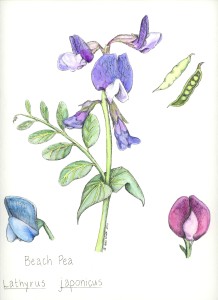 Beach pea, Abbie Korolik 2014 |
| Common Name(s) |
Sea Pea, Beach Pea |
| Scientific Name |
Lathyrus japonicus |
| Family |
Fabaceae |
| Location/Vegetative Zone |
Thicket |
| Flowering Period |
May – August |
| Identifying Characteristics |
Long stem with five to twelve purple flowers |
Description
- A native species to Sandy Hook
- Has a long green stem with five to twelve purple and blue flowers.
3,555 total views, no views today
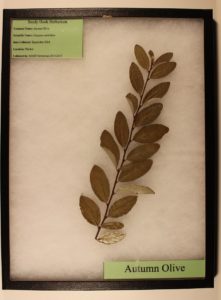 Photo Courtesy of K. Hubeny |
| Common Name(s) |
Autumn Olive, Japanese Silverberry |
| Scientific Name |
Elaeagnus umbellata |
| Family |
Elaeagnaceae |
| Location/Vegetative Zone |
Thicket |
| Flowering Period |
June-July |
| Identifying Characteristics |
3-4 meters tall, Pale yellow flower, red-brown fruit |
Description
- Grows from Maine to Virginia
- Has a life span of 30-40 years
- Fruiting period is from August to October
2,952 total views, no views today
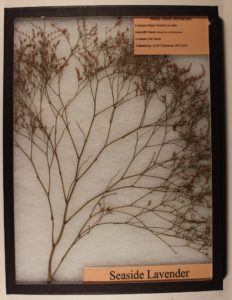 Photo Courtesy of K. Hubeny |
| Common Name(s) |
Seaside Lavender, Marsh Rosemary |
| Scientific Name |
Limonium carolinianum |
| Family |
Plumbaginaceae |
| Location/Vegetative Zone |
Salt Marsh |
| Flowering Period |
Summer |
| Identifying Characteristics |
Has blue to purple, and white petals. |
Description
• Grows 1 to 3 feet in height
• Grows well in salty, windy, and sandy conditions
• Has a woody base
• Leaves are 2 to 8 inches
Location
Cultural Uses
• Beds and borders
• Flowers often dried for decoration
2,448 total views, no views today
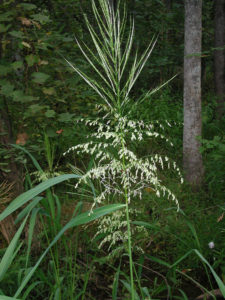 (“Wild Rice.” Eat The Weeds, www.eattheweeds.com/wild-rice/.)
|
| Common Name(s) |
Wild Rice |
| Scientific Name |
Zizania aquatica |
| Family |
Poaceae |
| Location/Vegetative Zone |
Shallow water in small lakes and slow-flowing streams |
| Flowering Period |
July-September, seeds ripen from September-October |
| Identifying Characteristics |
Grows up to 11ft, long leafless stalk with small yellow-white seeds at the top |
Description
- Annual plant
- Grows up to 11ft tall
- Leaves are:
- Lanceolate
- Flat, very thin
- 1 m long, 4 cm wide
- Purple leaf markings
- White to purple flowers
- Flowers tiny and grow on spikelets
- Bloom from July-September
- Produces a dark brown to black seed
- Seeds ripen from September-October
Misc
- Habitat:
- Shallow water in small lakes and streams
- Likes sandy, loamy, or clay soil
- Needs sunlight- cannot grow in shade
- Grows in Eastern North America , New Brunswick to Manitoba, south to Florida and Texas
- Edibility:
- Grain can be harvested
- When the seed is cooked, it can be used as a cereal
- Was a staple food source to the Native American Indians and the Chinese
- Has a high nutritional value and great taste
- High in protein, amino acids, and dietary fiber, and low in fat
- Can also be ground into meal and used to make bread
- In China, the stem is used as a vegetable
- Wild rice seeds can be infected by the highly toxic fungus ergot, which is dangerous if eaten. Infected grains have pink or purplish blotches.
2,539 total views, no views today
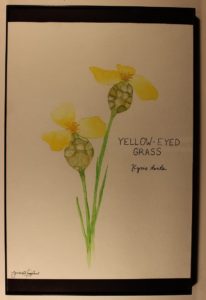 Yellow-Eyed Grass, Jasmine Hoagland
|
| Common Name(s) |
Yellow-eyed Grass |
| Scientific Name |
Xyris torta |
| Family |
Xyridaceae |
| Location/Vegetative Zone |
Marsh |
| Flowering Period |
May-July |
| Identifying Characteristics |
10-30in tall, leafless stem with a small yellow flower forming from a brown bulb |
Description
- Perennial plant
- Grows 30” tall
- Leaves are:
- Alternate, linear shaped
- Very thin
- 8-20” long
- Dark to light green
- Has small yellow flower
- 3 petals
- Yellow petals meet at an orange center
- Blooms out of a dark brown bulb
- Blooms in early summer, May-July
Misc
- Habitat:
- Bogs, fens, shores of rivers or lakes
- Likes moist, sandy, calcium-rich soil
- Is native to the eastern half of the United States, from Massachusetts to Alabama
- Typically found in open and sunny areas, with acidic soils and fluctuating water tables
- Most abundant of all plants in its class
2,718 total views, no views today
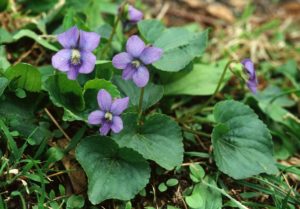 (“Viola Sororia.” Botanikim, Apr. 2009, botanikim.com/2017/06/14/viola-sororia/.)
|
| Common Name(s) |
Common Blue Violet |
| Scientific Name |
Viola sororia |
| Family |
Violaceae |
| Location/Vegetative Zone |
Woods, thickets, and stream banks |
| Flowering Period |
April-August |
| Identifying Characteristics |
3-8” tall, wide heart-shaped leaves, and large blue-violet flowers (sometimes white with purple veins) |
Description
- Perennial plant
- Grows 3-8” tall
- Leaves are:
- Downy, basal, heart-shaped
- Wide (3” long, 3” wide)
- Yellowish green to dark green depending on growing conditions
- Can be crenated or serrated along the edge
- Has blue-violet flowers
- 5 petals
- Medium to dark violet
- Inner throat of flower may be white
- Dark purple veins radiate outward
- Blooms from April-August for about 1½ months
- After blooming, the plant produces seed pods with many dark brown seeds inside; the seeds are ejected out of the pod
Misc
- Habitat:
- black soil prairies, open woodlands, woodland edges, savannas, and wooded slopes along rivers or lakes
- likes rich silty loam or clay loam with above average amounts of organic matter
- common to North America; grows from Wisconsin to the East Coast and north to Canada
- likes partial sun or light shade, and moist to average conditions, although full sun is tolerated if there is sufficient moisture
- Spreads easily; can be found in lawns, city parks, moist waste areas, and along hedges or buildings
- The flowers and leaves are edible, and some say that the roots are edible as well.
- The Cherokee Indians used it to treat colds and headaches. Has also been used to treat coughs, sore throats, and constipation.
- State flower of Illinois, Rhode Island, Wisconsin and New Jersey
2,954 total views, no views today
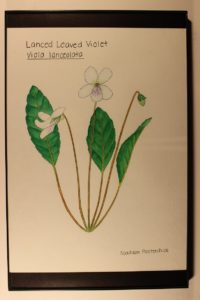 Lanced Leaved Violet, Madison Pasterchick
|
| Common Name(s) |
Lance Leaved Violet, White Bog Violet |
| Scientific Name |
Viola lanceolata |
| Family |
Violaceae |
| Location/Vegetative Zone |
Freshwater bogs, swamps, wet meadows and along shores in sandy soil |
| Flowering Period |
May-June |
| Identifying Characteristics |
10-15cm tall, lance-shaped leaves, 5 white petals- middle bottom petal has purple veins |
Description
- Perennial plant
- Grows 10-15 cm tall
- Leaves
- Narrow 2-6″ long, 1/4-3/4″ across
- Lance-shaped
- Smooth
- Wider in the summer than the spring
- White flowers
- Bottom three petals typically have purple veins
- Blooms for 3 weeks, from May-June
- After blooming, flowers turn into green elliptical shaped fruit capsules about ¼in long containing many small, dark brown seeds
- Habitat:
- Freshwater bogs, swamps, wet meadows, and along sandy shores
- Grows in sandy soil
- Originates in North America, but can be found in many states across the US and Canada
- Likes full sun and moist to wet conditions
Misc
- Is considered an ornamental plant, and can be used in flower arrangements
- Often hybridizes with the White Northern Violet (Viola macloskeyi) to form a combination plant, Primrose-leaved Violet (Viola primulifolia)
Sources
“Viola lanceolata“. Go Botany. New England Wild Flower Society. Web.
2,290 total views, no views today
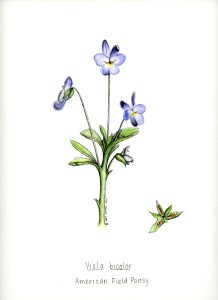 American Field Pansy, Abbie Korolik 2015
|
| Common Name(s) |
American Field Pansy, Wild Pansy |
| Scientific Name |
Viola bicolor |
| Family |
Violaceae |
| Location/Vegetative Zone |
Fields |
| Flowering Period |
Mid spring- early summer for 1½ months |
| Identifying Characteristics |
4-6” tall, slender basal-shaped leaves, and purple/white flowers with dark purple lines |
Description
- Annual plant
- Grows 6” tall
- Leaves:
- Small, basal-shaped
- 2” long
- Light to medium green
- Hairless and smooth
- Has purple/ white flowers
- 5 petals
- Medium blue-violet becoming white toward the center
- Dark purple lines radiating outward
- Blooms from March-June for about 1½ months
- Fertilized flowers produce seed pods with small, light brown seeds which are ejected out of the pod
- Habitat:
- Limestone glades, moist sand prairies, fields, edges of sandy paths, and waste places
- Likes light friable soil containing sand, but will adapt to other kinds of soil as well
- Is considered native to North America (although this is controversial) and can be found from Western Canada to the East Coast of the US down to Texas
- Likes full or partial sun, moist to mesic conditions and areas with a history of disturbance
Medicinal/Edible Uses
- Cooked down with sugar to make jellies and syrups
- Used to garnish plates
- Flavors some oils, vinegars, butters, and beverages
Cultural Uses
- Ornamental
- Romans used plant to make wine
- In medieval times, people would scatter American Field Pansy on the floor to freshen the air
- In the Victorian era the flower was used to make fragrances and perfumes
Misc
- Attracts bees, small butterflies and moths; many types of birds including the grouse and wild turkey feed on the seeds; deer and rabbits will feed on the foliage
- In the past, there has been some controversy regarding whether or not the Field Pansy is native to North America as it shares many characteristics with the Viola spp., a plant from Eurasia. However, the growing consensus is that the Field Pansy is a distinct species and therefore is considered native to North America
Sources
Boling, Janice. “Using Viola in Herbal Medicine and Home Remedies”. Every Green Herb. Web.
“Viola bicolor Pursh field pansy”. Plants Database. USDA NRCS. Web.
“Viola Flowers”. Specialty Produce. Web.
3,949 total views, no views today
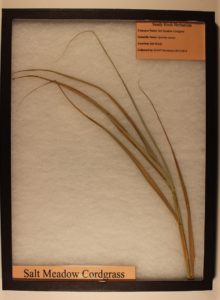 Photo Courtesy of K. Hubeny |
| Common Name(s) |
Salt meadow cordgrass |
| Scientific Name |
Spartina patens |
| Family |
Poaceae |
| Location/Vegetative Zone |
Salt Marsh |
| Flowering Period |
June-October |
| Identifying Characteristics |
Slender, wiry grass that grows 30-60 cm high |
Description
- 30-60 cm tall
- Leaves are green in spring and summer, turning brown in late fall and winter
- Wispy and hollow stems
- Deep purple flowers bloom from June to October
- Flowers and seeds are only on one side of the stalk
Location
[mapsmarker layer=”15″]
Cultural Uses
- Used for fodder during the colonial era
- Serves as a pollution filter and buffers against flooding and shoreline erosion
Sources
“Spartina patens (Aiton) Muhl. saltmeadow cordgrass”. Plants. USDA NRCS. Web.
1,933 total views, no views today










